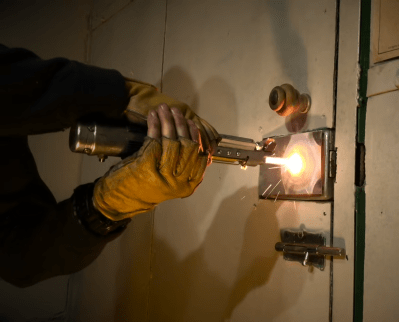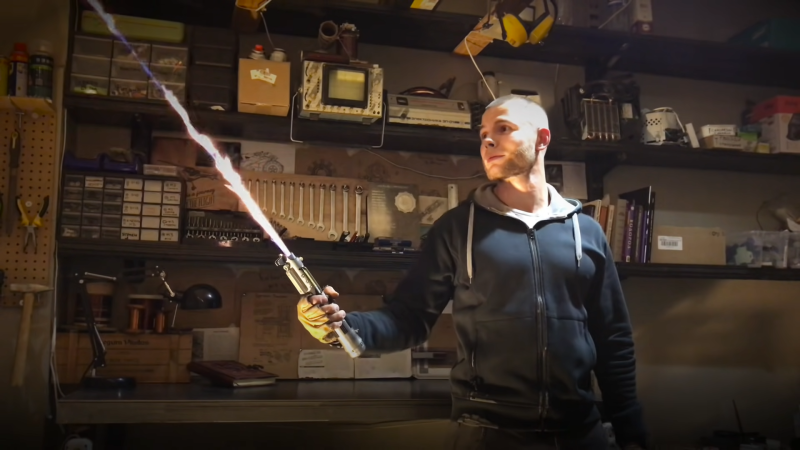As we all know, the lightsaber is an elegant weapon, for a more civilized age. [Alex Burkan] is doing what he can to bring that technology to fruition, and even secured a Guinness World Record in the process.

The build relies on an electrolyzer, splitting water into hydrogen and oxygen gas which is stored in a small tank. This gas can then be released and combusted in a burning stream, creating a weapon with a vague resemblance to a movie-spec lightsaber. With the hydrogen torch burning at temperatures of thousands of degrees, it’s hot enough to melt steel just like in the films.
While the concept of operation is simple, actually building such a device in a handheld size is incredibly difficult. [Alex] highlights key features such as the flashback arrestor that stops the gas tank exploding, and the output nozzle that was carefully designed to produce a surprisingly long and stable flame.
The resulting device only burns for 30 seconds, so you’ve only got a short period of time to do what you need to do. However, unlike previous designs we’ve seen, it doesn’t use any external gas bottles and is entirely self-contained, marking an important step forward in this technology. Video after the break.
[Thanks to Chuckz for the tip!]
















That is one very awesome build!
Very impressive, [Alex]!
Agreed. Best light saber ever.
Pressurized oxyhydrogen gas has such a low threshold for ignition that this guy will blow up his hand one day. It’s not a matter of if, but when if he keeps on doing it. Mark my words.
The minimum required ignition energy for mixtures with oxygen is so low (~1.2 microjoules) that it can be reached simply by opening the tank valve too fast so there’s a pressure shock. Metal rubbing against metal, catalytic chemical reactions against the tank wall… etc. everything can ignite it and often hydrogen explosions don’t have any clear identifiable cause. It just goes “bang” for no apparent reason.
http://www.hysafe.net/wiki/BRHS/HydrogenIgnition
dont worry … he has a beard
He should wear a safety tie
The sparking brushes of a spinning universal motor can ignite hydrogen. Once used a Henry vacuum cleaner to evacuate a hydrogen/oxygen (dilute in inert gas) mix from a rig. Poor Henry. He went kaboom!
It had worked well dozens of times, but after a different solution was used. One without sparks.
Both people in the room had beards, which kight explain why we were ok ;)
Should have used separate tanks for the hydrogen and oxygen.
I don’t know why ANYBODY uses mixed HOH gas. It’s not that hard to build an electrolysis rig that keeps them separate.
1.2 microjoules … that is way higher that what is needed to ignite an average russian ;-)
but yeah, it does have a bit of a cringe factor. remember Furze-meister anfd his trash jet engine?
Holy crap! Oxyhydrogen is extremely dangerous. DO NOT BUILD THIS.
Why is the flame orange? Hydrogen flame is blue, almost invisible.
Carbon-based fuels burn orange.
He said there is a small amount of alcohol used to make the flame longer. He did not elaborate on how it is used.
That always bugged me about Space Engineers
Impurities. Mostly the metal pipes the flame is touching at its base.
I once made a H2 O2 microtorch from a surgical needle. It burned with a blaytiful pale blue flame, until the pressure droped and it started touching the needle, it glowed bright yellow then, shortening the needle slowly in the process. And then the pressure dropped further and the flame disappeared along with the bottom of half of my electrolyzer (which was never found).
Well, it sounds like that might have been a memorable experience.
He is squirting alcohol through the flame to make the long saber and to be fair, he does admit this.
And to echo others, premixed H2 O2 is a suicidal technology.
Hmm. I watched with no sound, and missed that.
He mentions adding/squirting alcohol into the stream.
Lightsabers are silly, imagine what level the frequency of the blackbody radiation would need to be for something to burn anything at an even remotely useful rate, the thing would be so bright that it would blind you and give you skin cancer while using it.
Getting past the whole “fictional weapon” thing — the blade of a “real” light saber is made of ridiculously energetic plasma.
I’d imagine if you could figure out the whole “constrain said plasma into a functional blade” you could probably also know out how to contain the photons and radiation being emitted.
Yes that would be a key requirement. So what physical principle will allow the construction and control of a phenomenon that allows solid matter to pass through it so as to interact with the plasma, but can block highly energetic photons even >UV so perhaps X-rays, but still let some visible light pass?
It’s a pseudo tech from a different universe where none of ours applies:
– there is sound in space
– their galaxy is truly the size of the moon
– their stories revolves around building a moon sized weapon which will never fit in their universe, so it’s always destroyed.
Would separate chambers for the O2 and H2 make it any safer?
Infinitely.
In their liquid forms (and stored separately until they mix in the combustion chamber) they’re commonly used to power rocket engines used to carry payloads into space.
Wow ! That looks like a promising technology. I hope it was less confidential, I’ll see if I find any information on the ‘net. Any recommendation of where to start ?
The goal of Darwin Award is to NOT WIN Darwin Award!
and yet those still do go boom sometimes :P
This looks like fake. I don’t think a narrow horizontal stream of hot gas would behave like this. Should bend upwards due to the heat. When pointed to the melting metal plate the flame disappears in the plate. It should be spread to all sides as the burning gas does. Some cool tricks in video editing?
Top marks in the category of “tools likely to kill or maim the operator in normal use”. Major cool points, but better start building your cybernetic prosthetic hands now, before you need them.
This is NOT a light Saber but a kool flame thrower or torch. Gas is going to explode one day. True saber yeld power from kyber crystal witch are lazers
Shout-out to Alan Pan
youtu.be/u-xHso660tA
Pretty cool to see how that design evolved over the years! ^^